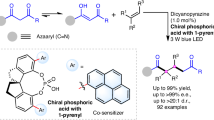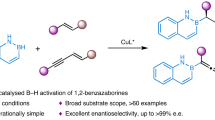Abstract
Most functional groups, especially those consisting of the abundant elements of organic matter—carbon, nitrogen and oxygen—have been extensively studied and only very few remain speculative due to their high intrinsic reactivity. In contrast to the well-explored chemistry of diazoalkanes (R2C=N2), diazoalkenes (R2C=C=N2) have been postulated in several organic transformations, but remain elusive long-sought intermediates. Here, we present a room-temperature stable diazoalkene, utilizing a dinitrogen transfer from nitrous oxide. This functional group shows dual-site nucleophilicity (C and N atoms) and features a bent C–C–N entity (124°) and a long N–N bond together with a remarkable low infrared absorption (1,944 cm–1). Substitution of N2 by an isocyanide leads to a vinylidene ketenimine. Furthermore, photochemically triggered loss of dinitrogen might proceed through a transient triplet vinylidene. We anticipate the existence of a stable diazoalkene functional group to pave an exciting avenue into the chemistry of low-valent carbon and unsaturated carbenes.

This is a preview of subscription content, access via your institution
Access options
Access Nature and 54 other Nature Portfolio journals
Get Nature+, our best-value online-access subscription
$29.99 / 30 days
cancel any time
Subscribe to this journal
Receive 12 print issues and online access
$259.00 per year
only $21.58 per issue
Buy this article
- Purchase on Springer Link
- Instant access to full article PDF
Prices may be subject to local taxes which are calculated during checkout




Similar content being viewed by others
Data availability
All data generated and analysed during this study are included in this Article and its Supplementary Information. Crystal structure data for the solid-state structures are available free of charge from the Cambridge Crystallographic Data Centre via https://www.ccdc.cam.ac.uk/structures/ under reference numbers CCDC-2013705 (2), CCDC-2013706 (3), CCDC-2013708 (4), CCDC-2013709 (5), CCDC-2043960 (6), CCDC-2043961 (7), CCDC-2043962 (9), CCDC-2043959 (10), CCDC-2013707 (12), respectively. The supplementary materials for this paper include synthetic and characterization data for all reported compounds as well as computational details.
References
Curtius, T. Ueber die Einwirkung von salpetriger Säure auf salzsauren Glycocolläther. Ber. Dtsch. Chem. Ges. 16, 2230–2231 (1883).
von Pechmann, H. Ueber Diazomethan. Ber. Dtsch. Chem. Ges. 27, 1888–1891 (1894).
Regitz, M. & Maas, G. Diazo Compounds: Properties and Synthesis (Academic Press, 1986).
Patai, S. The Chemistry of Diazonium and Diazo Groups (Wiley-VCH, 1978).
Hirai, K., Itoh, T. & Tomioka, H. Persistent triplet carbenes. Chem. Rev. 109, 3275–3332 (2009).
Sander, W., Bucher, G. & Wierlacher, S. Carbenes in matrixes: spectroscopy, structure, and reactivity. Chem. Rev. 93, 1583–1621 (1993).
Stang, P. J. Unsaturated carbenes. Chem. Rev. 78, 383–405 (1978).
Breidung, J. et al. Difluorovinylidene, F2C=C:. Angew. Chem. Int. Ed. 36, 1983–1985 (1997).
Brahms, J. C. & Dailey, W. D. Difluoropropadienone as a source of difluorovinylidene and difluorodiazoethene. J. Am. Chem. Soc. 112, 4046–4047 (1990).
Ervin, K. M., Ho, J. & Lineberger, W. C. A study of the singlet and triplet states of vinylidene by photoelectron spectroscopy of H2C=C−, D2C=C−, and HDC=C−. Vinylidene–acetylene isomerization. J. Chem. Phys. 91, 5974–5992 (1989).
Murcko, M. A., Pollack, S. K. & Lahti, P. M. An ab initio study of diazoethene, a propadienone isoelectronic with a bent structure. J. Am. Chem. Soc. 110, 364–368 (1988).
Knorr, R. Alkylidenecarbenes, alkylidenecarbenoids, and competing species: Which is responsible for vinylic nucleophilic substitution, [1 + 2] cycloadditions, 1,5-CH insertions, and the Fritsch−Buttenberg−Wiechell rearrangement? Chem. Rev. 104, 3795–3850 (2004).
Seyferth, D., Hilbert, P. & Marmor, R. S. Novel diazo alkanes and the first carbene containing the dimethyl phosphite group. J. Am. Chem. Soc. 89, 4811–4812 (1967).
Gilbert, J. C. & Weerasooriya, U. Diazoethenes: their attempted synthesis from aldehydes and aromatic ketones by way of the Horner-Emmons modification of the Wittig reaction. A facile synthesis of alkynes. J. Org. Chem. 47, 1837–1845 (1982).
Hansmann, M. M., Antoni, P. W. & Pesch, H. Stable mesoionic N‐heterocyclic olefins (mNHOs). Angew. Chem. Int. Ed. 59, 5782–5787 (2020).
Moss, R. A. Chemistry of alkanediazotates. Acc. Chem. Res. 7, 421–427 (1974).
Müller, E., Ludsteck, D. & Rundel, W. Ein neuer Weg zum Diazomethan. Angew. Chem. 67, 617 (1955).
Bierbaum, V. M., DePuy, C. H. & Shapiro, R. H. Gas phase reactions of anions with nitrous oxide and carbon dioxide. J. Am. Chem. Soc. 99, 5800–5802 (1977).
Wislicenus, W. Synthese der Stickstoffwasserstoffsäure. Ber. Dtsch. Chem. Ges. 25, 2084–2087 (1892).
Severin, K. Synthetic chemistry of nitrous oxide. Chem. Soc. Rev. 44, 6375–6386 (2015).
Eymann, L. Y. M. et al. Synthesis of organic super-electron-donors by reaction of nitrous oxide with N-heterocyclic olefins. J. Am. Chem. Soc. 141, 17112–17116 (2019).
Klein, S., Tonner, R. & Frenking, G. Carbodicarbenes and related divalent carbon(0) compounds. Chem. Eur. J. 16, 10160–10170 (2010).
Aldeco-Perez, E. et al. Isolation of a C5-deprotonated imidazolium, a crystalline “abnormal” N-heterocyclic carbene. Science 326, 556–559 (2009).
Lorberth, J. Metallorganische diazoalkane III. Diazoalkane mit germanium, blei und den iib-elementen zink, cadmium und quecksilber als substituenten. J. Organomet. Chem. 27, 303–325 (1971).
Sotiropoulos, J.-M., Baceiredo, A. & Bertrand, G. Synthesis and reactivity of diazomethylenephosphoranes (P=C=N2). New phosphacumulene ylides and first stable pseudo-unsaturated diazo derivatives. J. Am. Chem. Soc. 109, 4711–4712 (1987).
Baceiredo, A., R‚au, R. & Bertrand, G. Phosphorus substituted “CN2” groups: building blocks in heterocyclic chemistry. Bull. Soc. Chim. Belg. 103, 531–537 (1994).
Cox, A. P., Thomas, L. F. & Sheridan, J. Microwave spectra of diazomethane and its deutero derivatives. Nature 181, 1000–1001 (1958).
Liu, W. et al. Mesoionic carbene (MIC)-catalyzed H/D exchange at formyl groups. Chem 5, 2484–2494 (2019).
Glendening, E. D. et al. NBO 7.0 (Theoretical Chemistry Institute, University of Wisconsin, 2018)
Landis, C. R. & Weinhold, F. 3c/4e σ̂-Type long-bonding: A novel transitional motif toward the metallic delocalization limit. Inorg. Chem. 52, 5154–5166 (2013).
Bott, K. Dialkylamino‐substituierte Ethylendiazoniumsalze. Chem. Ber. 120, 1867–1871 (1987).
Bott, K. 2,2-(n,n′-dimethyl-ethylendiamino)-ethylendiazonium-ion, ein diazonium-ion mit ungewöhnlichen eigenschaften. Tetrahedron Lett. 26, 3199–3202 (1985).
Papakondylis, A. & Mavridis, A. Electronic structure and bonding of the fastidious species CN2 and CP2: A first-principles study. J. Phys. Chem. A 123, 10290–10302 (2019).
Su, M.-D. & Chuang, C.-C. Theory predicts triplet ground-state carbene containing the N-heterocyclic carbenic unit. Theor. Chem. Acc. 132, 1360 (2013).
Bott, K. Alkenediazonium salts: A new chapter of classical organic chemistry. Angew. Chem. Int. Ed. 18, 259–265 (1979).
Tang, C. et al. 1,1‐Hydroboration and a borane adduct of diphenyldiazomethane: A potential prelude to FLP‐N2 chemistry. Angew. Chem. Int. Ed. 56, 16588–16592 (2017).
Krossing, I. & Reisinger, A. Perfluorinated alkoxyaluminate salts of cationic Brønsted acids: synthesis, structure, and characterization of [H(OEt2)2][Al{OC(CF3)3}4] and [H(THF)2][Al{OC(CF3)3}4]. Eur. J. Inorg. Chem. 2005, 1979–1989 (2005).
Lucius, R., Loos, R. & Mayr, H. Key to a general concept of polar organic reactivity. Angew. Chem. Int. Ed. 41, 91–95 (2002).
Bestmann, H. J., Schmid, G. & Sandmeier, D. Synthese eines stabilen Alkylidenketenimins und eines Alkylidenthioketens. Angew. Chem. 87, 34–34 (1975).
Bestmann, H. J., Schmid, G. & Kumulierte Ylide, I. X. Eine neue Synthesemöglichkeit für N‐substituierte (Triphenylphosphoranyliden)ketenimine und das (Triphenylphosphoranyliden)thioketen. Chem. Ber. 113, 3369–3372 (1980).
Alcarazo, M., Lehmann, C. W., Anoop, A., Thiel, W. & Fürstner, A. Coordination chemistry at carbon. Nat. Chem. 1, 295–301 (2009).
Wang, Z., Herraiz, A. G., del Hoyo, A. M. & Suero, M. G. Generating carbyne equivalents with photoredox catalysis. Nature 554, 86–91 (2018).
Acknowledgements
This paper is dedicated to the memory of Manfred Regitz. This work was supported by the Fonds der Chemischen Industrie (scholarships to M.M.H. and P.W.A.), DFG (X-ray: INST 186/1324-1) and BMBF (tenure-track programme for M.M.H.). Computational resources were provided by the DFG project 405832858 and LiDO3, the high performance computing facility at TU Dortmund (DFG project 271512359). M. Alcarazo is thanked for granting access to his infrastructure at the University of Göttingen, D. Munz and F. Weinhold are acknowledged for helpful computational discussions. A. Ofial and C. Sindlinger are thanked for providing 8 and [H(Et2O)2]{Al[OC(CF3)3]4}, respectively. D.A.P. acknowledges support from the Max Planck Society. The members of the chemistry department at TU Dortmund are thanked for their support, in particular W. Hiller for the 14N and 15N NMR measurements.
Author information
Authors and Affiliations
Contributions
All experiments were conducted by M.M.H. (initial discovery) and P.W.A. Crystallographic analyses of borane adducts 4 and 5 were performed by J.J.H. and C.G. measured and refined the remaining solid-state structures. DFT, NBO and NRT calculations were performed by M.M.H. and MP2, CASSCF, NEVPT2 and CCSD(T) calculations were performed by D.A.P. The project was designed and coordinated by M.M.H who also wrote the manuscript.
Corresponding author
Ethics declarations
Competing interests
The authors declare no competing interests.
Additional information
Peer review information Nature Chemistry thanks Peter Schreiner and the other, anonymous, reviewer(s) for their contribution to the peer review of this work.
Publisher’s note Springer Nature remains neutral with regard to jurisdictional claims in published maps and institutional affiliations.
Supplementary information
Supplementary Information
Experimental data, synthesis and characterization data, NMR spectra, X-ray crystallographic data, computational details, Supplementary figures and tables.
Supplementary Data 1
Crystallographic data for compound 2. CCDC reference 2013705.
Supplementary Data 2
Crystallographic data for compound 3. CCDC reference 2013706.
Supplementary Data 3
Crystallographic data for compound 4. CCDC reference 2013708.
Supplementary Data 4
Crystallographic data for compound 5. CCDC reference 2013709.
Supplementary Data 5
Crystallographic data for compound 6. CCDC reference 2043960.
Supplementary Data 6
Crystallographic data for compound 7. CCDC reference 2043961.
Supplementary Data 7
Crystallographic data for compound 9. CCDC reference 2043962.
Supplementary Data 8
Crystallographic data for compound 10. CCDC reference 2043959.
Supplementary Data 9
Crystallographic data for compound 12. CCDC reference 2013707.
Rights and permissions
About this article
Cite this article
Antoni, P.W., Golz, C., Holstein, J.J. et al. Isolation and reactivity of an elusive diazoalkene. Nat. Chem. 13, 587–593 (2021). https://doi.org/10.1038/s41557-021-00675-5
Received:
Accepted:
Published:
Issue Date:
DOI: https://doi.org/10.1038/s41557-021-00675-5
This article is cited by
-
Metal-free organocatalytic S-formylation of thiols using CO2
Nature Catalysis (2024)
-
Arenes participate in 1,3-dipolar cycloaddition with in situ-generated diazoalkenes
Nature Chemistry (2023)
-
Copper-catalyzed Z-selective synthesis of acrylamides and polyacrylamides via alkylidene ketenimines
Nature Communications (2022)
-
More details on diazoolefins
Nature Chemistry (2021)
-
Isolation and characterization of diazoolefins
Nature Chemistry (2021)





